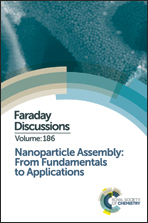Analyzing a fractal gel of charged oblate nanoparticles in a suspension using time-resolved rheometry and DLVO theory
Abstract
The disk-like nanoparticles of LAPONITE® are known to self-assemble to form a fractal gel within hours after a sufficiently large concentration of LAPONITE® is dispersed in water containing salt. The concentration of sodium counterions associated with LAPONITE® particles, however, continues to increase over a period of days, suggesting that delamination of LAPONITE® disks from stacks is sluggish and/or dissociation of counterions is slow. In either case, spontaneous self-assembly of LAPONITE® particles occurs even though delamination and/or counterion dissociation has not reached its equilibrium state. In order to determine the nature of the fractal gel as the extent of delamination and/or dissociation progresses towards equilibrium, we subject the LAPONITE® suspension to a freezing–defrosting cycle, which interestingly reinitiates the gelation process in suspension afresh. Application of time-resolved rheometry to a defrosted suspension shows that iso-frequency loss tangent curves intersect at an identical point, validating the Winter–Chambon criterion for a critical fractal gel state. Interestingly, while the time required to form a critical gel is observed to decrease with increased time elapsed since preparation, at which freezing–defrosting is carried out, the fractal dimension of the critical gel is observed to remain unaffected. We also solve DLVO theory for free energy interactions between the negatively charged LAPONITE® particle faces and analyze the observed phenomena.
- This article is part of the themed collection: Nanoparticle Assembly: From Fundamentals to Applications

 Please wait while we load your content...
Please wait while we load your content...